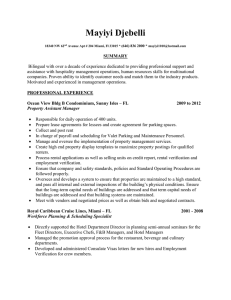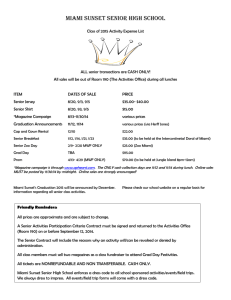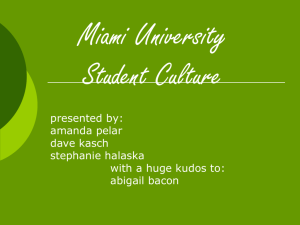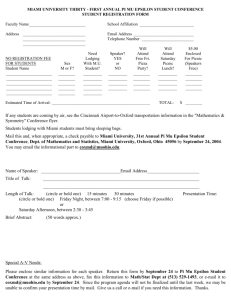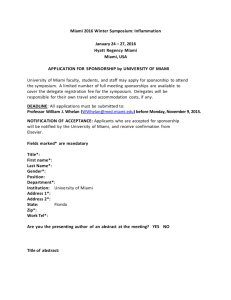The Miami Palace Hotel: Senior Creative Thesis Rachel Handel Spring 2006
advertisement
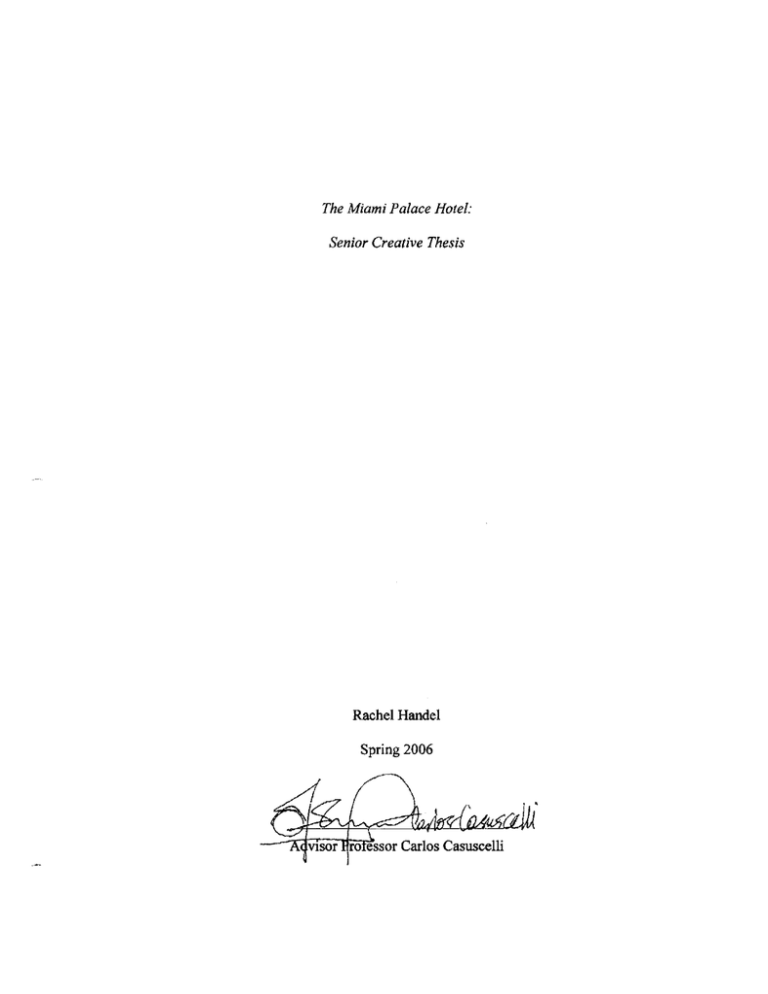
The Miami Palace Hotel:
Senior Creative Thesis
Rachel Handel
Spring 2006
_ pCelj
"The
J c,
J 1"'""-,
ACKNOWLEDGEMENTS
1
{2 (' C' ;:;:
.H3
I would like to thank several people for their support though this discovery
process. First, my gratitude is due to my thesis advisor, Professor Carlos Casuscelli. His
spirit guided the way on my personal journey to understanding and enjoying Miami. His
wisdom, encouragement, and simple suggestions made all the difference along the
designing process. University of Miami Professor Jamie Correara should also be
recognized for the way he made hard work and sacrifices worth the rewards. His
lighthearted attitude was much appreciated when things seemed rough. Lastly, I would
like to thank my close friends and family for engaging in stimulating conversations
always resulting in a deeper search oflife's questions, trials, and truths.
2
ABSTRACT
Living in Miami was the perfect opportunity to explore the freedoms and
limitations of a city through architecture. The rich past needed to be respected and
represented, but not copied. The present could be reflected through design, but not
wholly embraced; Miami is complex. The future is unknown but inevitable, so the design
aimed to achieve a sense of timelessness to age and grow with the city.
Designing a hotel was ideal to the place whose beauty and peace attracts worldly
travelers year round. With a program including ballrooms and convention centers, the
hotel could also contribute to the local culture. Miami's South Beach is home to some of
the world's most renowned hotels such as architect Morris Lapidus's Eden Rock &
Fontainebleau Hotels, the Shore Club, the Delano, and countless others. Each exuded a
distinct aura of peacefulness, extravagance, and exclusive style. The Miami Palace Hotel
must do the same in order to achieve a level of enticement that would be comparable to
the context.
AUTHOR'S ANALYSIS:
Intent:
Architecture is often described as an art with social responsibility. This creation
must positively influence users on a daily basis as well as the green environment decades
in the future. A person could easily become weighed down with the burden of these
social issues at hand - especially when juggling them along with performance,
technology, codes, form, aesthetics, and the list goes on. Nevertheless, designers are
dreamers, and architects are conductors.
They have the ability to design a change and
3
orchestrate a solution. The relationship that exists between the architect and the
building, before it ever even affects the public, is vital in determining the success of the
building.
In the same way, if an architect experiences a city, he or she will be better
equipped with the knowledge and understanding of the place and culture that will
ultimately create a better building for the site. While spending a semester in Miami,
Florida, the comfortable and understandable scale of the midwest was completely
reversed. Innitially, it was easy to feel lost among the perplexity of the urban life.
Through exploring the history, students began to understand the present context of Miami
and its surrounding areas. The scale was not comparable to Muncie, but it had many of
its own attributes. The ocean was, perhaps, the most mesmerizing attraction in the Miami
context. An architectural project here does not have to be the center of attention. The
building would not need to be the purpose, because it would always take second seat next
to the attractions already present in Miami.
As a whole, Miami is greater than the sum of its parts. With this gestalt, the
context carries a great deal of responsibility to the past, present, and future communities
of the area. This project presented an opportunity to add to that atmosphere, to be
another example of work and passion pouring out among the Miami landscape.
The other side of this social art comes from the artist's heart and mind. This
individual is responsible to the type and quality of relationship between the public and the
buiding. He or she dreams of this environment and then pursues the completion with the
belief that it will ultimately result in a better place for the people. While the architect
takes many facets of users' desires and needs into consideration, an intimate connection
4
and understanding of this art are ingrained in that individual. Designing a public building
in an urban setting carries social weight, but is also an intimate experience between the
designer and the city.
Context:
The greatness of Miami can be traced to Henry Flagler's railroad that brought its
first passengers on April 15, 1896. The main component of any city is people, and this
transit system provided access to the south shores. Prior to this, the beauty of south
Florida was inaccessible and unengaged. After the prominent atmosphere became
known, the city grew rapidly in size and in attractiveness. Starting in the 1930s, Miami
was booming with timelessly beautiful Art Deco architecture. Eden Rock, Shore Club,
Fontainebleau, and the Delano are just a few ofthe hotels that drew crowds from around
the globe in the climax of the city's infamy. To this day, they remain a success in
preserving the aura and bold simplicity of the Miami Shores.
In the 1980's, Miami was cited as having the highest murder rate of any city in
the United States. A noticeable decline in the area's popularity quickly followed. Only
within the past several years has Miami been on a strong path to full recovery from the
fall. The city is, once again, at the forefront of progressive thought. Miami boasts a
diverse culture, astounding beauty, a rich past, and a promising future. Architecture
plays a role in every aspect of the city's identity.
5
Precedent Studies:
Miami is magnetic; it attracts travelers worldwide and leaves visitors always
wanting more. For these reasons, the relationship between the context and the hotel was
conceived as a positive and negative presence. Miami's history and vivacity has such a
strong positive presence. Hence, the Miami Palace Hotel would have a stronger
relationship to the context as a negative magnetism. It would exist because of the
surrounding environments. Its purpose would not be inwardly focused, but would direct
attention to Miami. For these reasons, I studied architects that dealt with similar
relationships and design solutions.
Amancio Williams is a Latin American architect who built The House on the
Stream at Mar del Plata, Argentina in 1945. The design draws shape from the nature of
the brook and responds conceptually to the character of the topography. It establishes a
relationship between the context and the built environment with simple geometry. Unlike
language, numbering systems, or customs, geometry is common ground to all cultures.
Thus, simple movements such as these often do not need to be explained or described by
words. Viewers do not need to understand the genius ofthe concrete's structural parabolic
section to appreciate its mastery. The sight is simple and has proved to be of an elegance
that spans generations (Curtis 503-31).
Like Amancio Williams, Chad Oppenheim uses simple fonns to capture the beauty
of the natural surrounding. Oppenheim is an architect currently making a lasting impact on
the Miami skyline. His finn, Chad Oppenheim Architect + Design, is governed by
principles stemming from the South Florida culture. The experience of Miami varies from
one extreme to another. The nightlife, traffic, people, sounds, smells and tastes are all
6
extremely wild and fast-paced. The shore, however, is a lasting peace. In such a culture,
beauty is found in simplicity. Oppenheim literally captures these moments of clarity
through his architecture. Architects often focus more on the look of the building rather
than the way it looks at the world. The genius of Oppenheim's designs is the way they
master both arts simultaneously (Oppenheim 2).
The design intent of the Miami Palace Hotel was to orchestrate simplicity from
the complexity of the program and the power of the context. The Miami Palace Hotel's
location provides the perfect opportunity for a grand building with an all-encompassing
program catering not only to its visitors, but to the surrounding communities. While it
will be a spectacular place, it must also be a simple frame for the vivacious surroundings.
The balance between complexity, intrigue, and simplicity must be mantained without
compromise in order for the Miami Palace Hotel to reach its maximum potential.
The Miami Palace Hotel will look out over beautiful Key Biscayne. This island
has just been accessible since the construction of the Rickenbacker Causeway in 1963.
Since then, high-income neighborhoods have been built on the southside of the island.
This site is in the mid-section of the island. Its location serves visitors well
serene on
all sides, but just a short drive from downtown Miami. The local homeowners will
appreciate the business of travelors, but their privacy will not be breached. The hotel will
explore the relationship to the serene beach and the urban downtown. The site is now a
vast and empty parking lot approximately 600' by 600'. One side of this location
engages the beach. The program will encompass not only hotel ammenities, but that of a
community center for the island.
7
Concept:
Through the process of design, the complexity of the program was molded into
the simplicity of the resulting building. A concept of magnetic spaces was explored due
to the powerful attractive [positive] nature of Miami. The hotel will become a negative
force as it draws views from within by framing another environment. In this way,
'negative' does not define a harmful or pestimisting connotation, but a negative
magnitism - grounds in which to hold the positive actions.
Because of the openness of the curent site, a strong axis was created to establish a
grand entrance - one with heiarchy and importance. The main drive leads to the valet
drop-off where guests' luggage is taken to the back of house service areas. Guests then
ascend into the grand lobby. On the main axis, this lobby is a square tube, framing the
beauty that surrounds. It is cut open at both ends to reveal views that stretch onto the axis
of the entrance drive one way, and onto the ocean and beach beyond in the other
direction. Large glass doors lead to balconies and plazas outside. Extending 20 more
feet from these doors, the frame allows the feeling of outside and inside to become
blurred together. The scale of this tube funnels people, drawing them by the outwardlyfocussed building to the positive attraction of Miami.
Within the program, I explored the concept of magnetism, as well. The hotel
tower and cultural center are located on either side of the main axis and lobby. I first
defined which programmatic functions might become the positive, negative, and neutral
aspects of the concept. The hotel lobby would be the most likely reason people would
come to the Miami Palace Hotel. It was the reason, the appeal, so it took on a positive
connotation. These magnetisms were expressed through material. The hotel tower was
8
made with a more substantial concrete material. The cultural center by nature of function
and magnetism had a more transparent darkened glass
fa~ade.
Once these rules of
magnetism and axis were established, the Miami Palace Hotel took shape.
Reflection:
This project was a result of the designer's intimacy with the city of Miami, and
throughout the process this intimacy grew deeper. I saw that the city was not a collage of
cultural pieces, but a masterpiece from the paramount characteristics of each. The
architecture tells of the great history of the area. Recently, the design-conscious attitude
(and therefore architecture) has spread as Miami has once again become one of the
world's most progressive environments. In designing with such contextual issues, it was
important to respect the area while still making a contributive design statement. The
intent was that the Miami Palace Hotel would simply state: Miami is a beautiful place
meant to be admired by those fortunate enough to be within its presence.
9
CONTEXTUAL PHOTOGRAPHY
[PHOTOS BY THE AUTHOR UNLESS OTHERWISE NOTED]
Ab ove: Inside the Delano Hote l
Left: The Delano Hotel
Below: Chad Oppenheim
Building in Miami
Photo/rom
www.oppenojfice.com
Below: Fontainebleau
10
Above: the Shore Club Plaza and Interior Lobby
Right: The Shore Club hotel Tower with Framed Views
Above: Framed Beauty of Miami Hotels
Right: Yard of the Fontainebleau
11
WORKS CONSULTED:
Chad Oppenheim Architecture + Design. "Portfolio." October 2005. < http://www.
oppenoffice.com/>.
Curtis, William Jr. Modem Architecture Since 1900. New York: Phaidon Press, 2003.
Emporis Buildings Research. "Chad Oppenheim: Ten Museum Park." February 2006. 1
March 2004. < http://www.emporis.com/enlwmlbul?id=19301O>.
Student's Signature: _ _ _ _ _ _ _ _ _ _ _ _ _ _ _ _ Date_ _ _ _ __
Advisor's Signature:
Date_ _ _ _ __
FAX NO. :3054485827
FROM : IDeM I AM I
Mar. 13 2006 07:28AM
1.6t4 P,QGI/COI
Apr-12-2QCS
F~Z30
11
WORKS CONSULT£O:
". Curtis,. William Jr. Modern Architcstpre Since 1900. New York: Pbaidol1 Press,
03.
"'Bmporis &jJdings ~ "Chad ~enheim; Ten Museum Park.'It P'ebnwy 006. 1
6
M&l'Oh 2004...~ hup:II.:www.~ris.coml~id;1230] 0>.
Student·sSignature!_·~~~~~~4J._+~_Date'~~~~~J
Advisor's Siptufe:_l.::=--:~~::::::"::::J.¢;.t:::;;;_ _ _ _ Datc'~~I..£+Il-~:...c.i....v
Pi
l> -0
..........
n 0
::r ib'
o~
0
I
VI
V'I
0
::;::.
~
_.
Q)
3
.....
n ""'0
:0
OJ OJ
Q)
~ Q)
VI
n
- n rt>
IOJ
~ ~ I
0. ~ 0
9ro
ro ro
rl'
=rt>
i
/
\
......~ • 'If-"
.. ... .. ··it
~..
.,.
~
...
/
'.
\.
.
'
\
I
,
I
I
i
South Florida is attractive to visitors because of the year long
beauty. To maximize the potential of the hotel, the architecture
constantly frames the views of the surrounding environment.
Studying a 'Jenga' model, it was interesting to see the solids and
voids created by simple geometry. Looking at Chad Oppenheim's
work for inspiration, the Miami Hotel Palace emerged with framed
view and a strong axis
\ ..,.a ....
. ~ : .1.
::!1
....
,....
l/l
"T1
00
....
"
Q)
~
•
,
•
,
.,
;
,
r
,
:::1
c
•
f
~
'\
\
"
"
"
...
-
- - - -
parking garage
"
fitness center
~
.. ..
-.
•6.
••
patio
-
'----_ _ _ _ _ _ _ _....LJIIll1IJIII
,
galleryl
hurricane
shelter
L -______________ mmJJl...ll....-1~
~
•
Second Floor Plan
•
1:......-_/
o"
c
.....
~
::r
o"
o
.....
t,
, (~
.- -.
.(
,',
"T1
~
:r
"T1
o
o
• • • ••-
1£a::J::
J
Vl
X'
.-+
~
."
o
o
...,
admin.
..
~
x
~
~
"'T1
0
0
~
\j
CiT
~
I ....
"'T1
o
o.....
-0
cu
::J
o
.....,
"'T1
0-
o.....
Vl
(Xl
I
-'
o
QI
::J
0..
~
I
_II
."
o
o
"'"
~
Q)
::J
o
......
."
o
o
"'VI"
-...
I
w
-}
,
I
.....
~,~
;c.,
II>
II>
;:::;"
;:;:
C
C
tD
tD
0
c:
a.
8
8...
'0
II>
II>
ii'
;:::;:
c
AI
....
c)"
C
- - - - - - - - - !.:..
...
AI
::J
...a.
tD
~
AI
...
c:
AI
:l
....
tD
~I
DI
cr
AI
